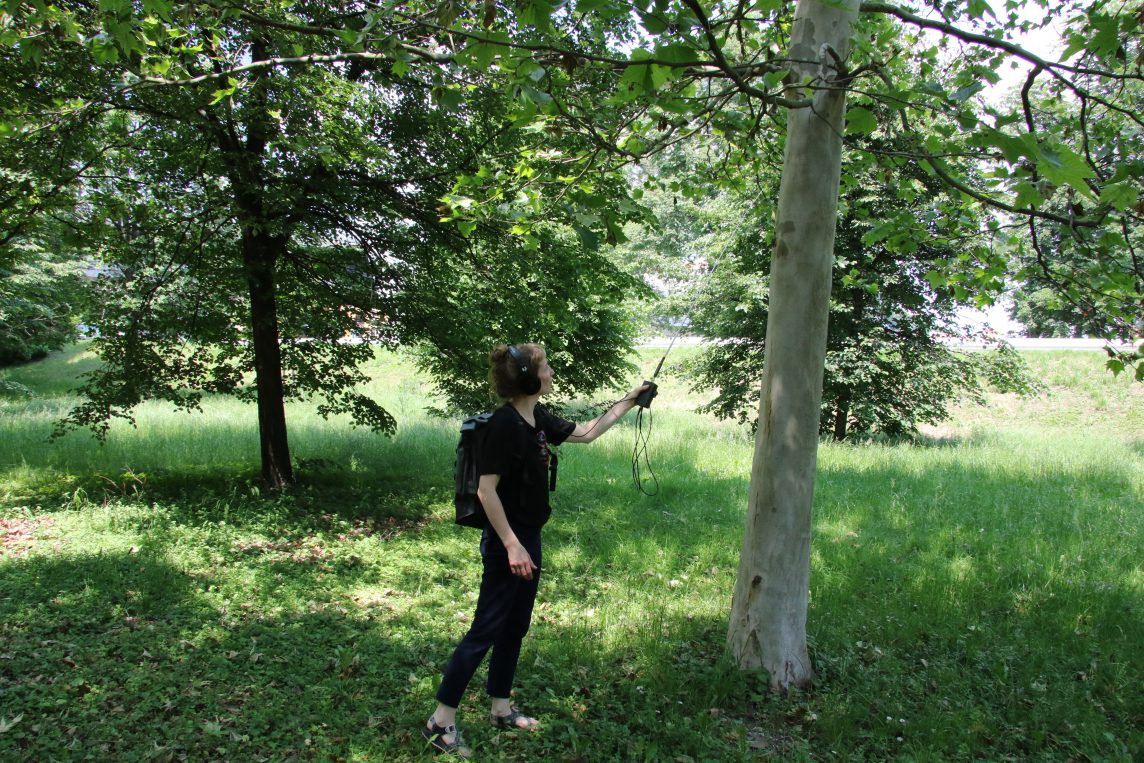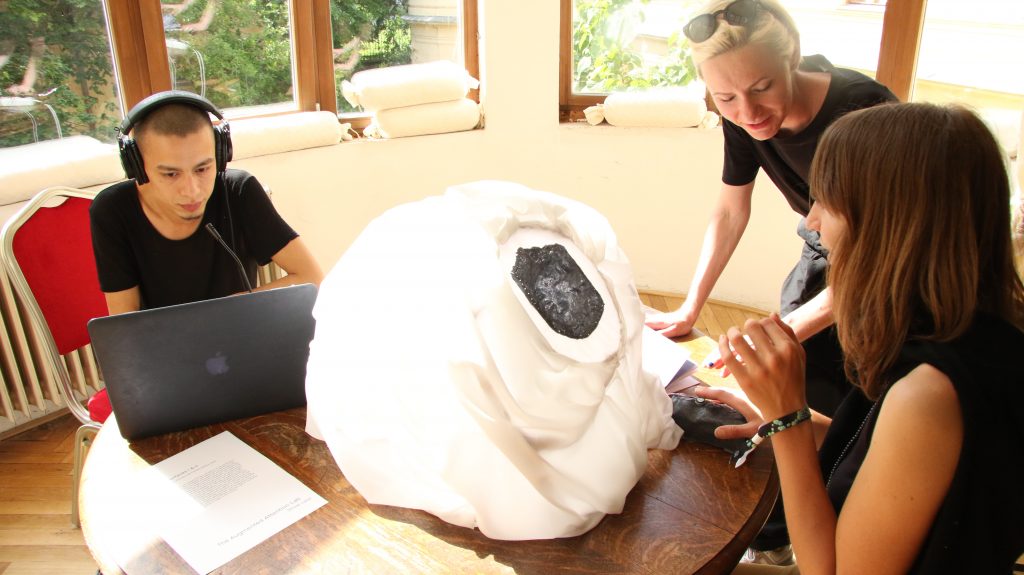On the 3rd of June 2019 we welcomed 16 participants from all over the world to the first-ever edition of The Augmented Attention Lab – a 4 day pressure-cooker focused on prototyping new technologies, gestures and practices, which challenge the ways in which we pay attention. The Augmented Attention Lab was a part of Sensorium Festival in Bratislava, Slovakia. Following our open call, we had carefully chosen a diverse group of makers and thinkers, who we believed would bring a unique insight to the theme of Augmented Attention. And we had hit the nail right on the head! To be honest, we were blown away by the collaborative spirit that afforded so many late nights of working, and the sharing of so many thoughts, references and ideas on the topic.
Here is a small re-cap of what came out of our 4 days together, in the scorching heat under the roof of the AFAD architecture department in Bratislava:
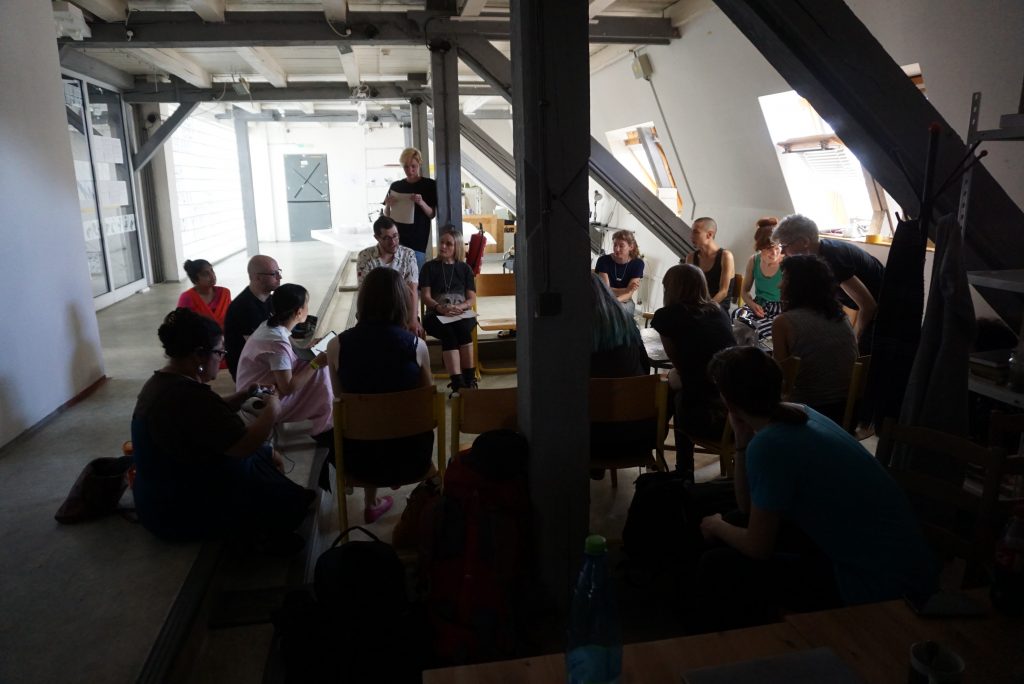
Day 1
We started out the day by giving an introduction to our work, and initial thoughts and ideas regarding the concept of “augmented attention”. Referring primarily to our work Sensory Cartographies, we shared our artistic work focusing on the creation of body extensions, performative gestures and new technologies, which challenge our culturally and evolutionarily conditioned modes of paying attention.
Anthropologist Tim Ingold describes our perception of the world as an ‘education of attention’. He states; ”Through fine-tuning of perceptual skills, meanings immanent in the environment are not so much constructed as discovered” (…) “artists are making present and composing attention”.
In the workshop we wanted participants to think about the objects, practices, gestures and technologies that draw forth some aspects of the world, that might otherwise be hidden, overlooked, or which drowns in a present, where we’re constantly overloaded with information. How can we think of attention as something that is temporal, something that can be composed?
Looking at perception from a strictly biological standpoint the body constantly filters out signals in a sea of impressions, in order to not become overwhelmed by information. Furthermore, we’re culturally conditioned to pay attention to certain sensory inputs in our environments, while filtering out others (think of cultures and societies particularly attuned to the direction and movements of the wind, for instance). This have implications for our survival, as our ability to attend, react and adapt to the environmental changes occurring around us are the determining factor of our survival as a species. In this lab we wanted to ask: In a present where environmental change is the single biggest challenge to our species, how can an awareness of our perceptual limitations foster new ways of creating technologies and practices for augmenting our own modes of attention?
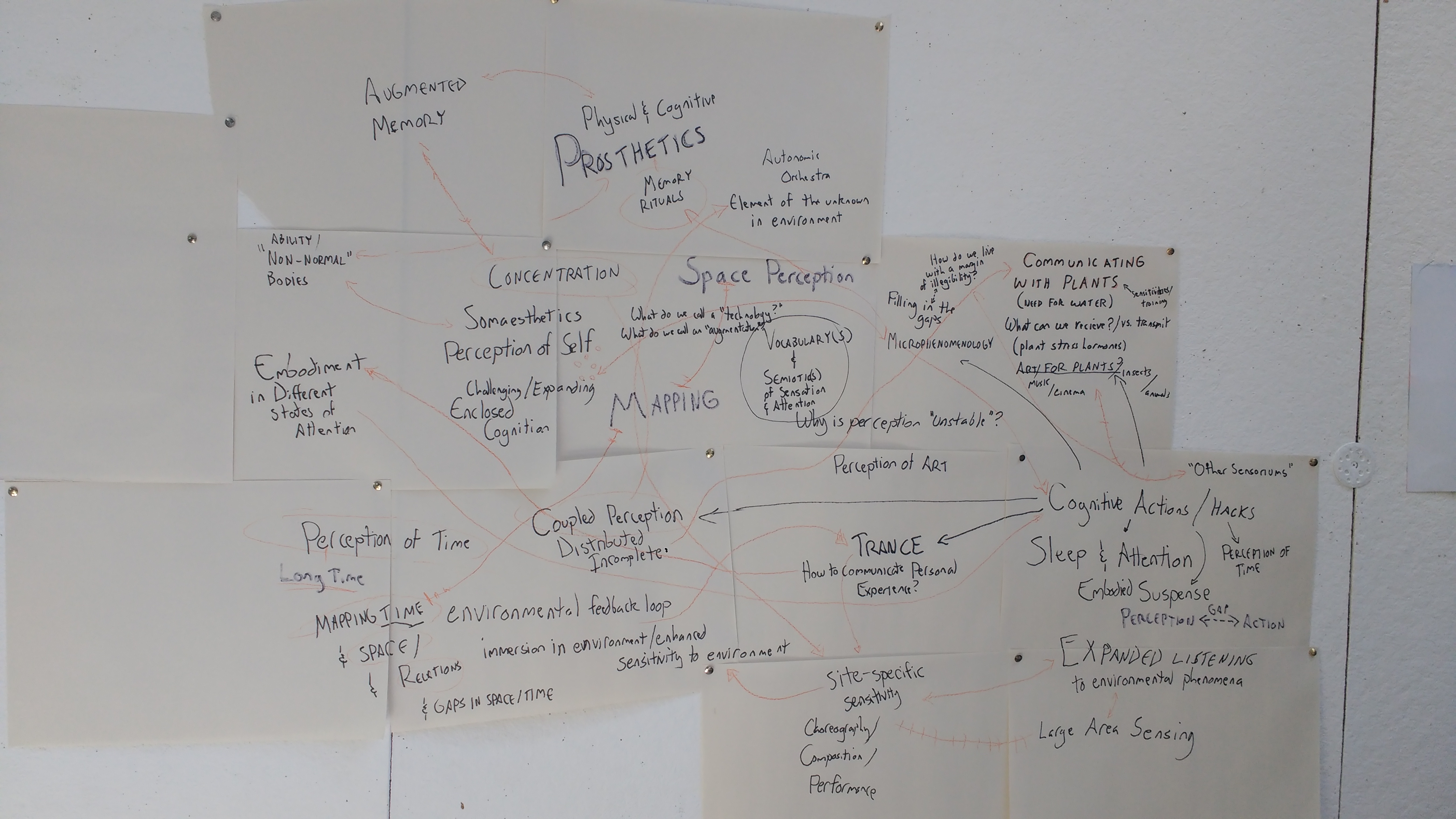
In the collective brainstorm that followed our presentation it was inspiring to see how the interests and ongoing research projects of the participants overlapped our own interests and expert areas. Above is a mind map of the ways in which these themes connected.
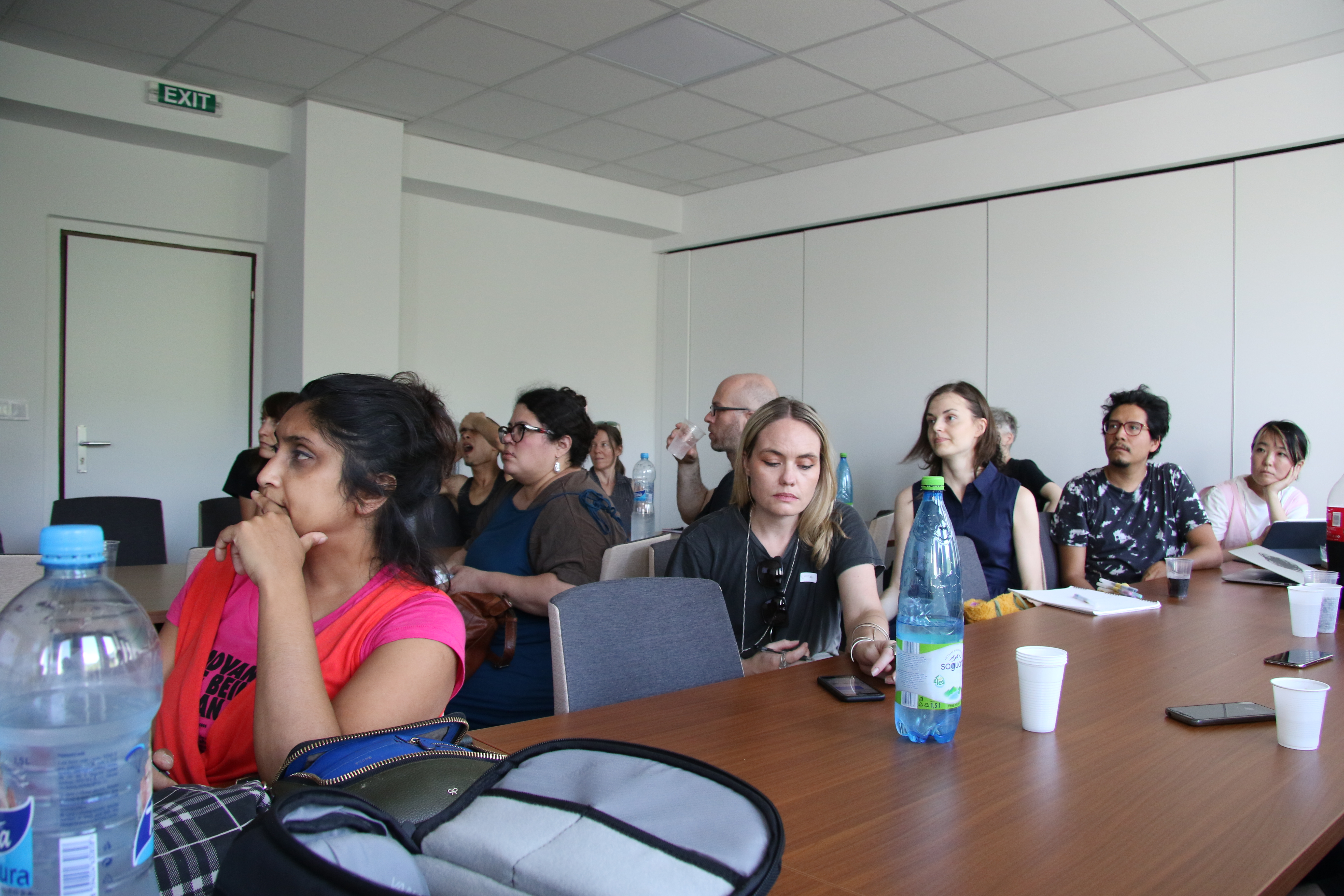
In the afternoon we had arranged a visit to the Center for Cognitive Science at Comenius University Bratislava, by invitation of Dr. Igor Farkaš and his colleagues. This field trip was intended to give participants an opportunity to take our discussions on perception and attention into a completely different field. Roman Rosipal from the Institute of Measurement Sciences gave a thorough introduction to the scientific side of measuring cognitive activity related to attention, and we had a lively discussion about the measureability of the human lifeworld!
Day 2
On the second day of the lab we were exited to have Marcello Lussana as our guest mentor. Marcello presented his work on embodiment, mindfulness and interactive sound (see a video on his work Sentire here), with a specific focus on a research method he uses in his PhD research, called Microphenomenology. Microphenomenology is a research technique that enables us to formulate and understand all the fine gradations of human experience. Marcello uses it as a way to research his technologically mediated experiments with sound.
After lunch we went for a walk in which participant Nik Forrest presented their research and technological tools enabling a practice of “listening otherwise”. Participants were able to explore the hidden sound world of the city through Nik’s VLF antenna.

Afterwards Marcello show cased a microphenomenology interview with participant Nicole, focusing on a specific moment in which her attention shifted, while listening to the very low frequencies present in the environment. Needless to say, we were all spellbound by the richness of information that can be explored and extracted in a moment lasting only a few seconds. Nicole really had to scrape her mind for every single little detail, and it became a very intimate and special experience witnessing her time-travel back into this moment, through the thoughtful guidance of Marcello.
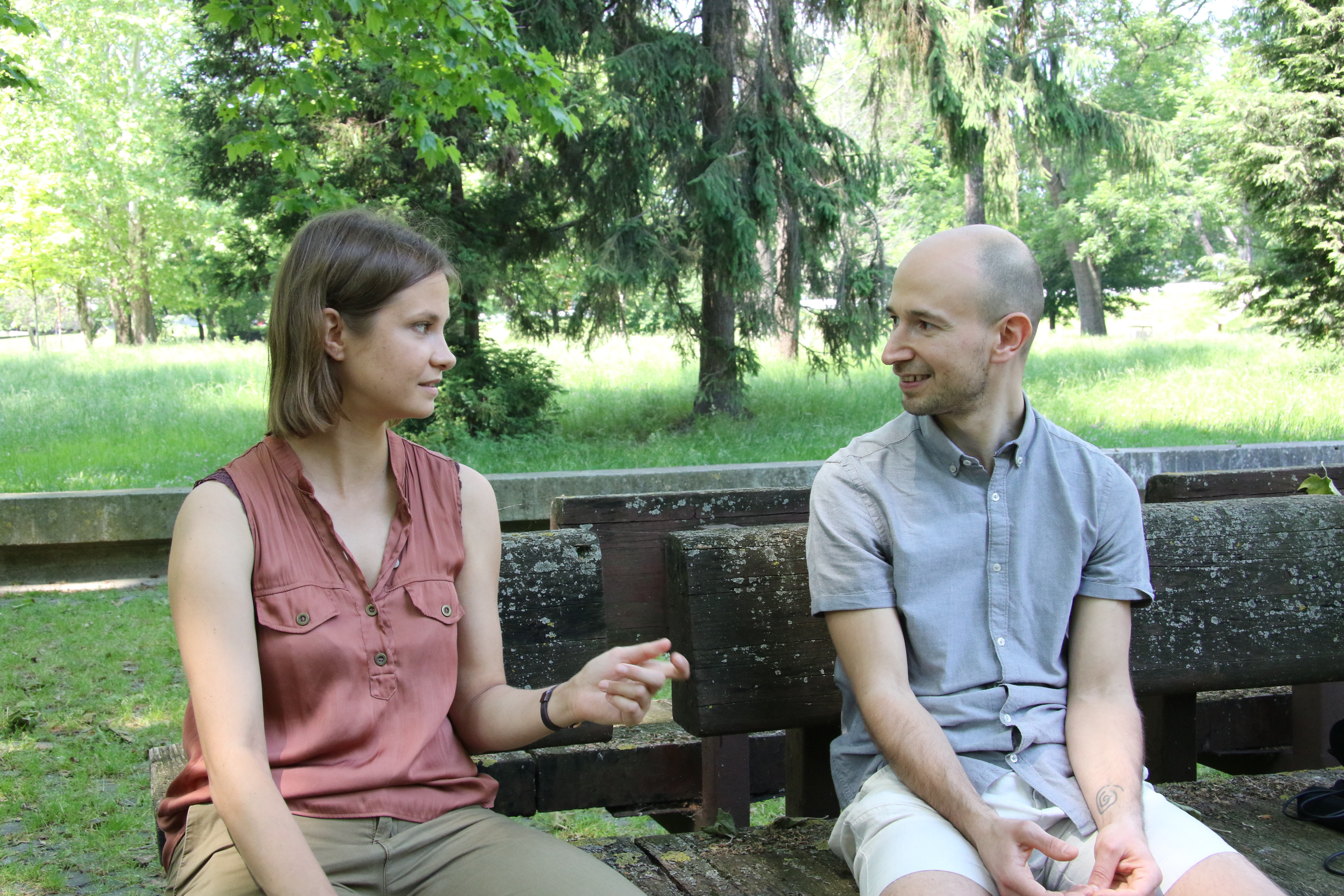
By now everyone had been chatting, hanging out and having drinks on the lively streets of Bratislava, and ideas and collaborations were starting to form. By the end of day 2 everyone’s fingers were itching to get started on their projects.
Day 3
On day 3 we got down to work. We had the joy of welcoming George Profenza, a creative technology polymath from London, who got right down to business helping everyone realize their ideas. 4 groups had formed between participants developing new collaborative works, and 3 participants were working on their own, further developing existing projects.
**Soon we’ll upload videos of the groups explaining their works!**
Below is a few shots of the busy workshop:
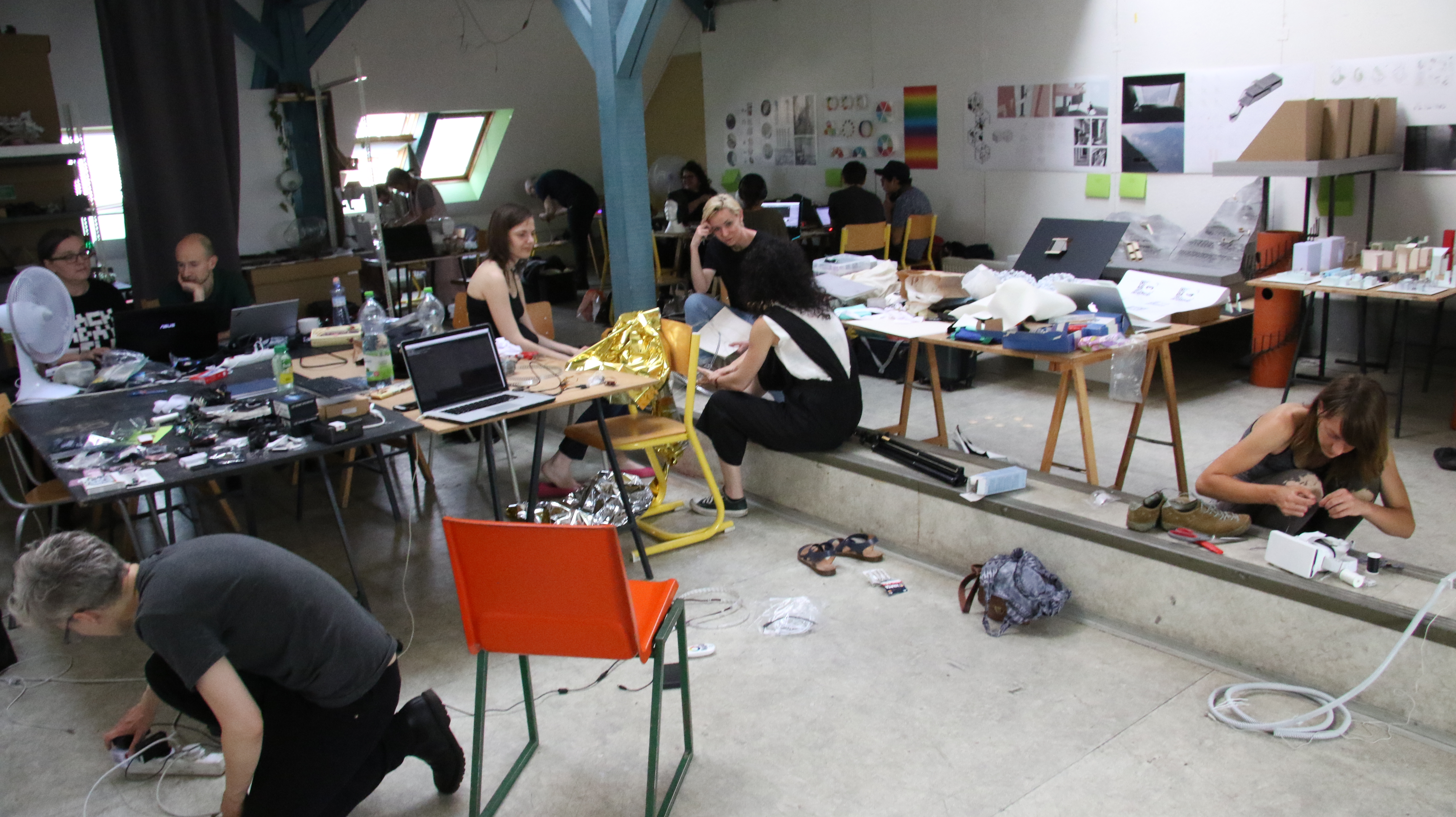
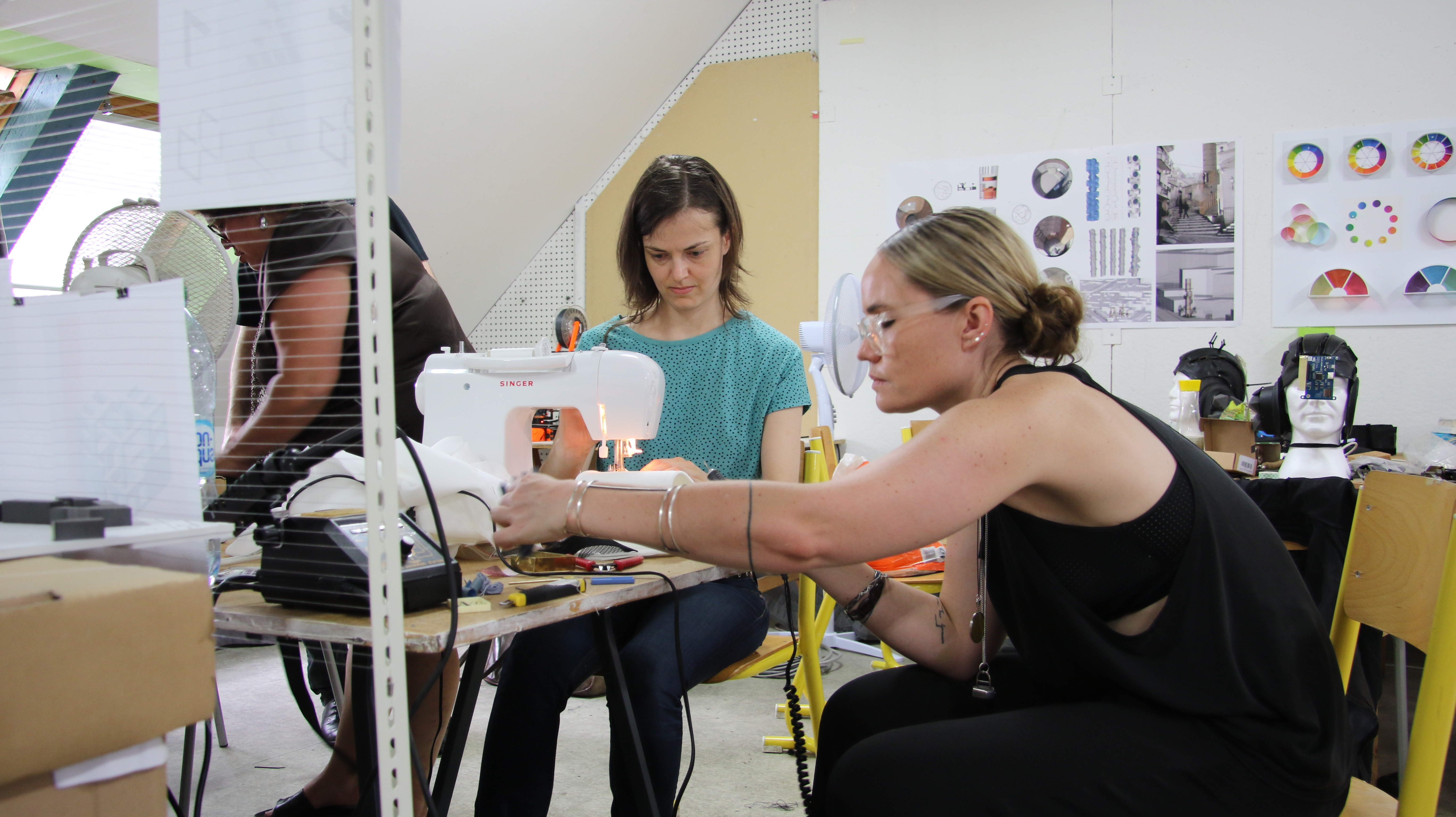
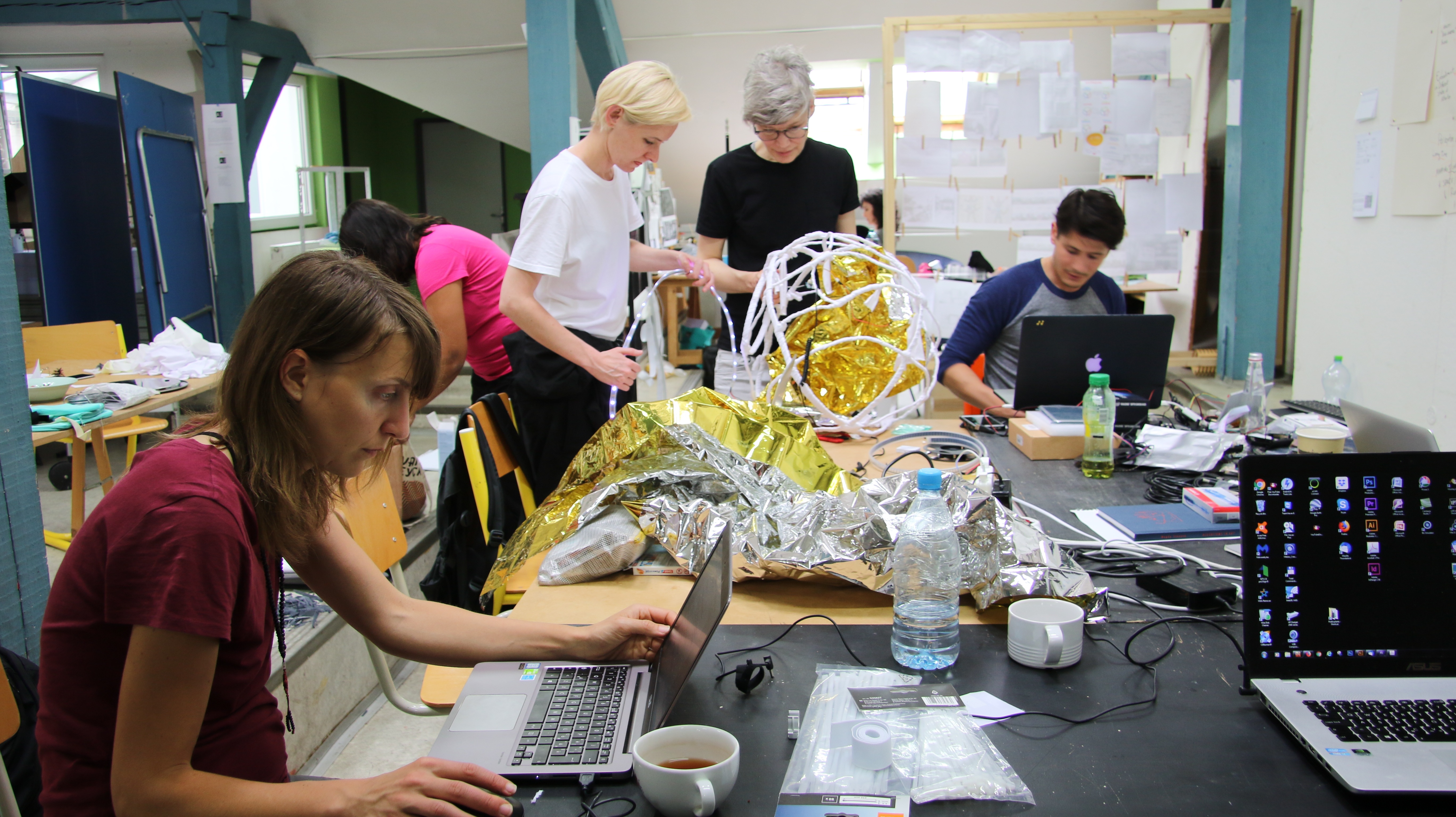
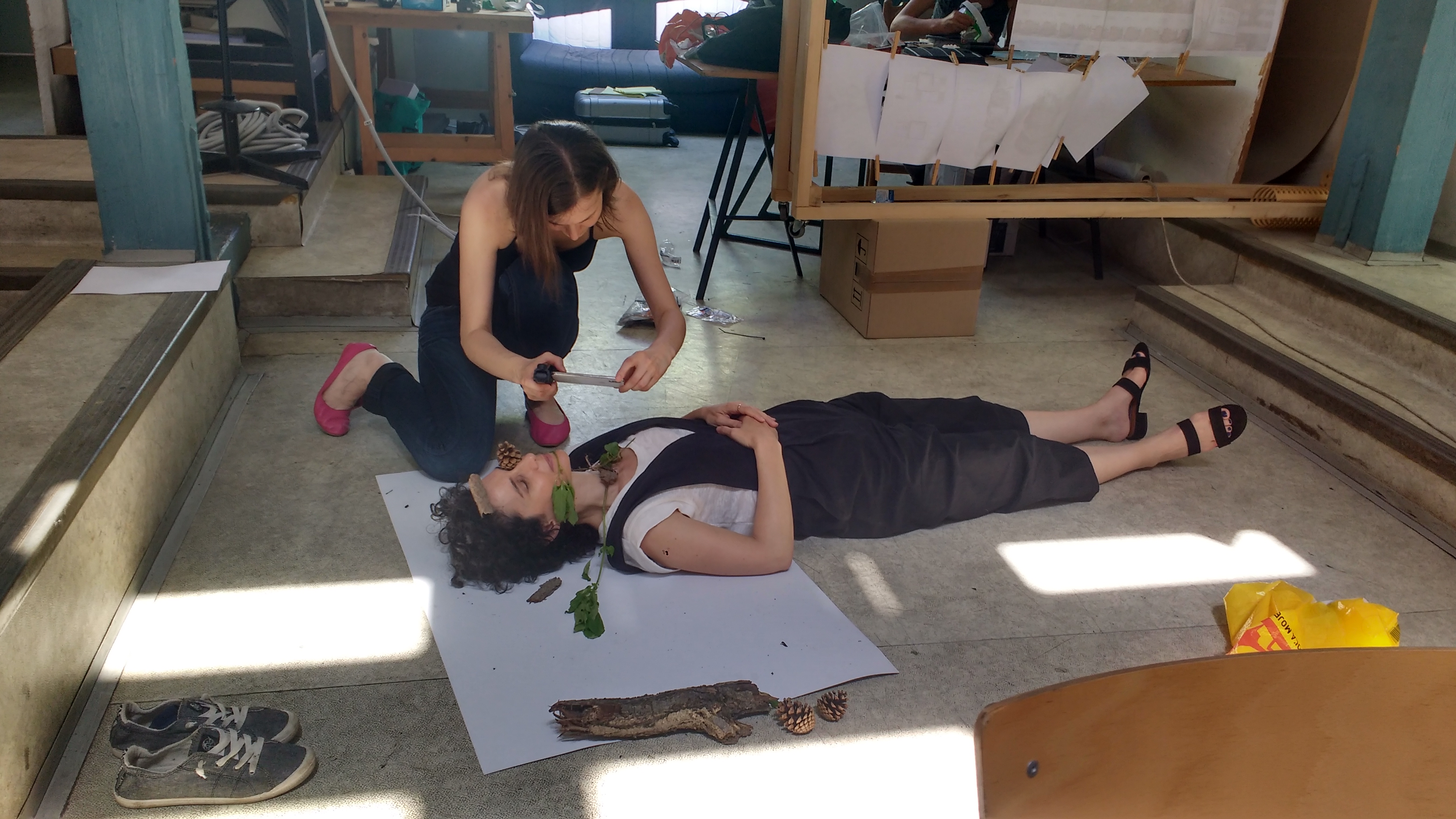
Day 4
On day 4 we continued working hard to finish the projects. Furthermore we had a mini-break, in which participant Magda Stanova introduced her practice, and the role of map-making in her work. She showed her fascinating body of work that explores the multiple ways in which you can map a city (such as Venice for instance), showing that mapping conventions are by no means complete.
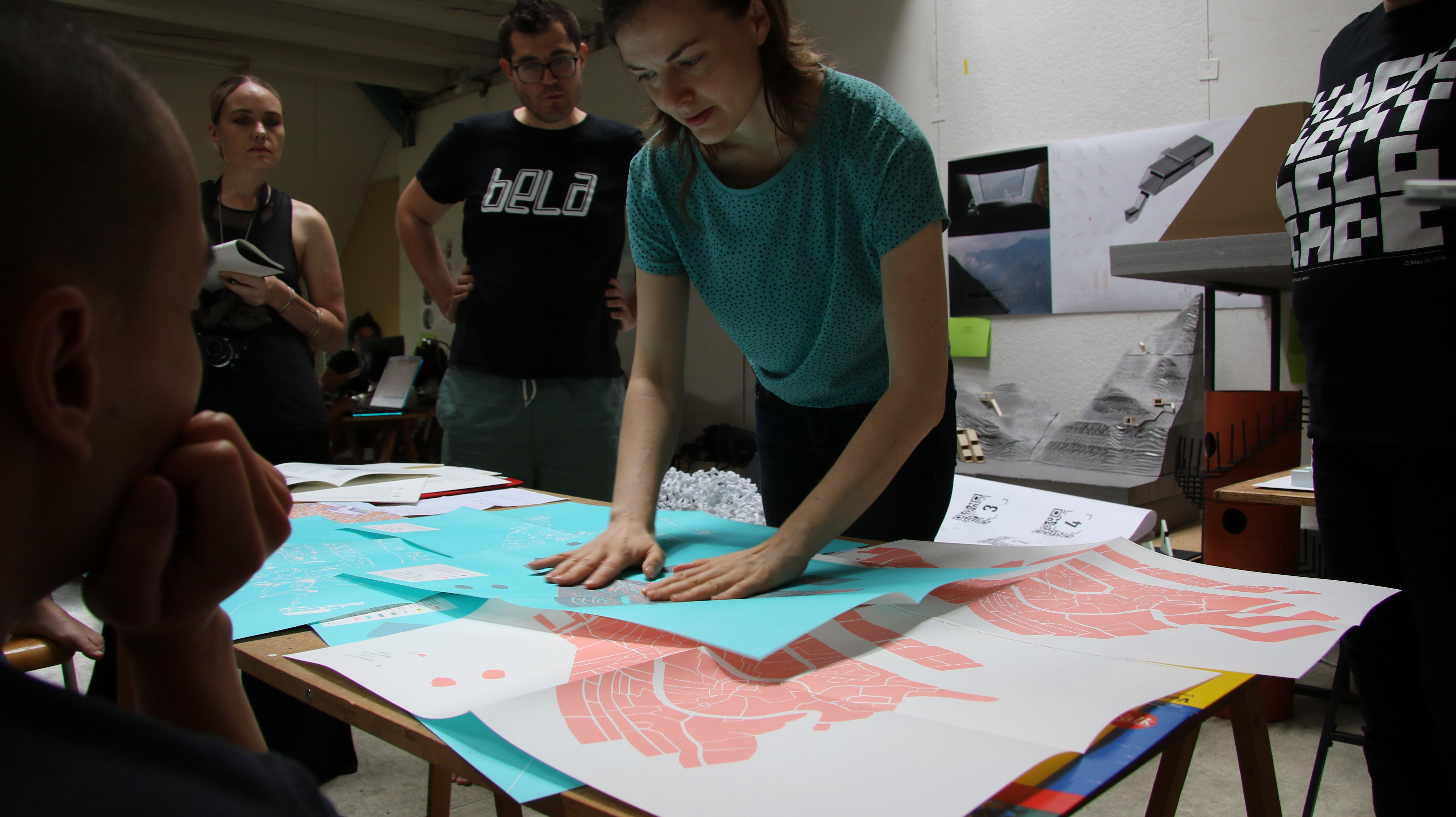
Day 5
On day 5 Sensorium Festival opened, and The Augmented Attention Lab was invited to show case the projects that had been developed in the short amount of time we had worked together in Bratislava. We were truly amazed with how hard and determined the participants were working to finish and present their works. Below are some images and descriptions of the works!
Audible Interactive Poetic Plant
by Lavoslava Benčić
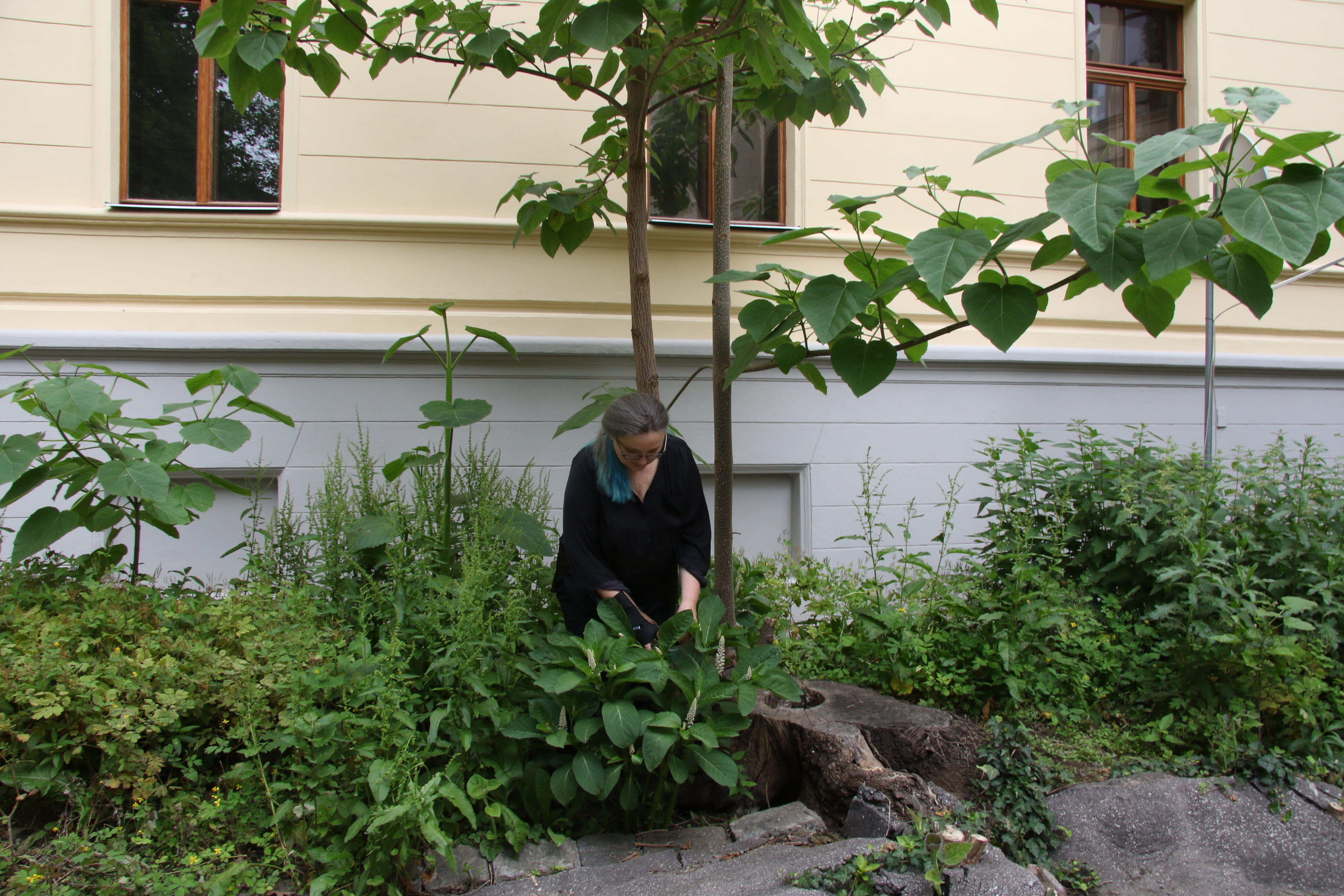
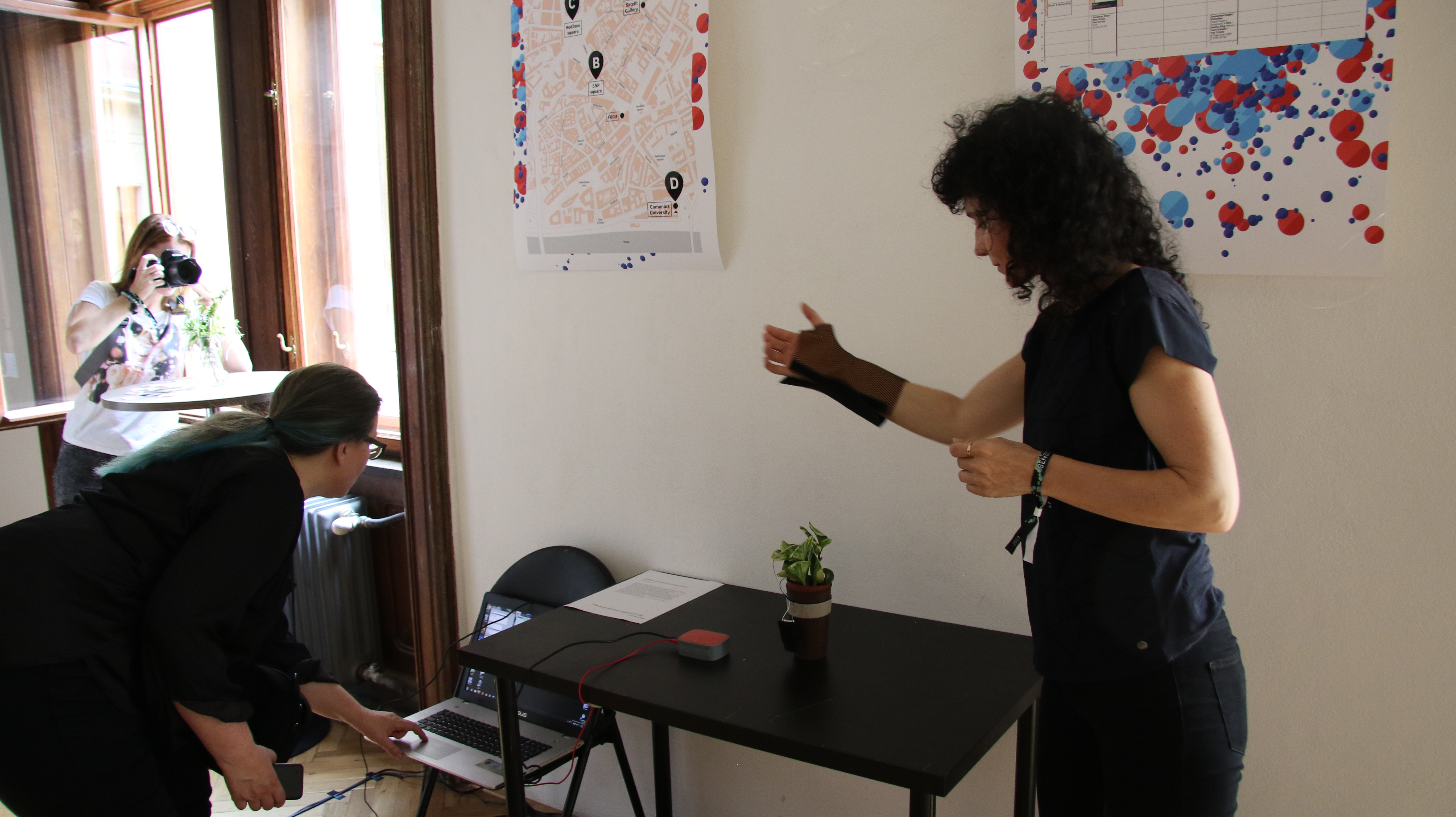
Description of the project: The project Audible Interactive Poetic Plant is a continuation of Lavoslava Benčić’s work in e-textiles and follows her collection of wearable – interactive gloves (2016-2019) made at Rampa Lab in Ljubljana (Slovenia). The idea is to show symbolically that humans should protect plants and other living creatures and they will offer us everything we need. In the research and the project at the Augmented Attention Lab in Bratislava, plant and human body are combined in an interactive wearable in a unique sound space. The result of the project is a fully functional prototype. It will be shown as a one hour presentation – short performance and demonstration. In the project we use SenseStage system (receiver and two transmitters). One transmitter sends the data from accelerator sensor placed on the glove. Second transmitter sends the analogue data about capacitive properties of the plant. Output sounds are generated from graphical sounds in SuperCollider (granular synthesis method). Both parts of the project (glove and plant) as a whole propose spectators to interact and create the unique sound space.
Enantiomorph Study
by Hanns Holger Rutz, Nayari Castillo, Emma Luke


Description of the project: A shape is said to be enantiomorph if it cannot be made congruent with its mirror image. Many of the human organs exhibit this property, such as the hands or the ears. These variations are called fluctuating asymmetries. In this work two participants become enantiomorph of each other, exchanging visual and auditory modalities by cross-wiring senses. This coalescence of these sensory inputs questions perceptions of self and space.
https://frama.link/enantiomorph
The hand thinks faster than the brain
by Alois Yang, Elke Mark, Lindsey French, Nicole Schimkus
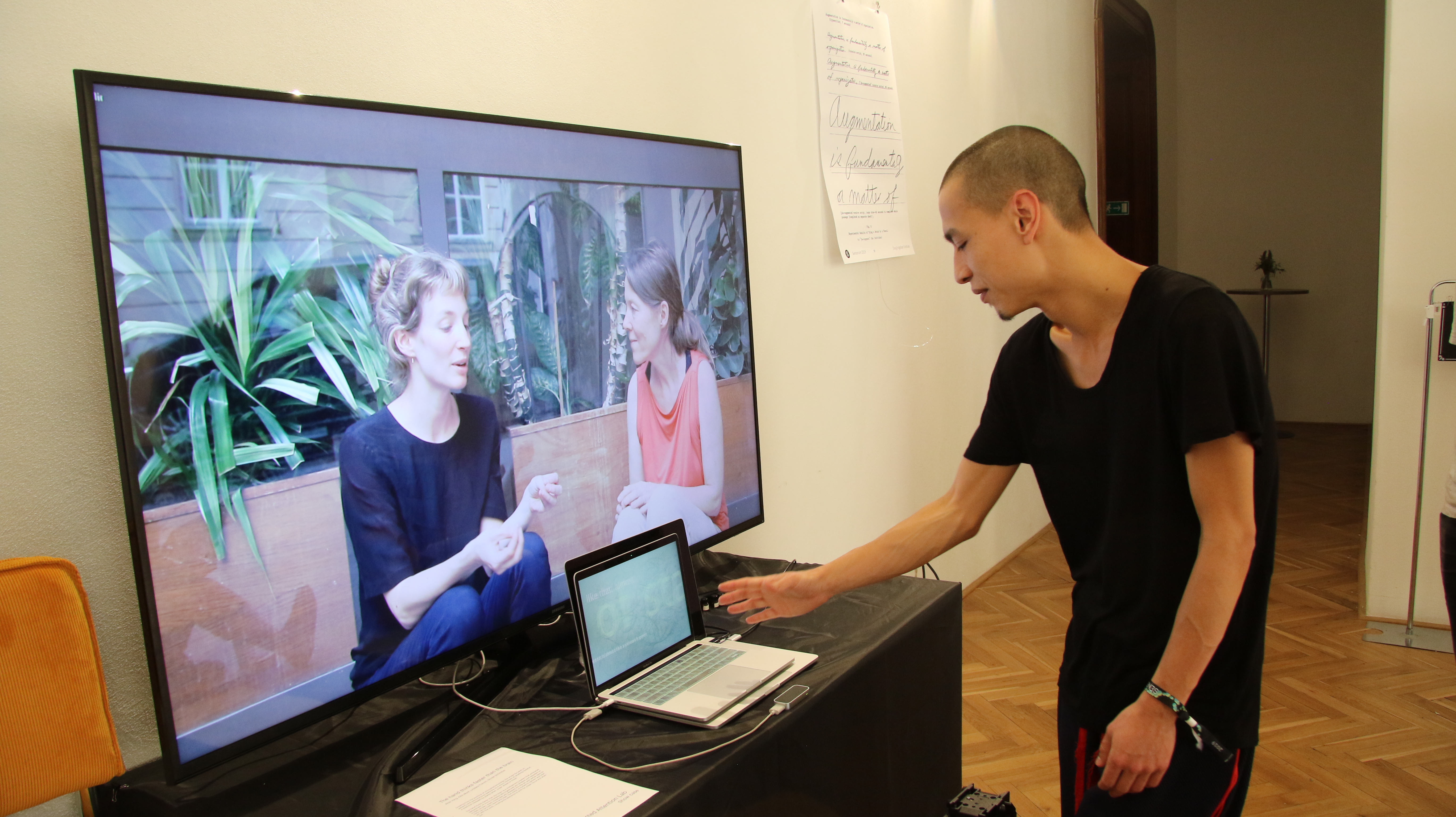
Description of project: Drawing from the practice of microphenomonolgy, the artists focused on sensory and subconscious reactions to a micro moment of smelling Hexanal, a chemical released by plants when under stress or threat. The hand thinks faster than the brain is a multisensory system that embraces reenactment of micro-moments. Microgestures are isolated and repeated on a video screen, scent molecules are released into the air, and verbal descriptions can be both heard and read. The visitor is invited to reenact and interact with the work, causing the elements to shift for closer focus and attention.
Intimate Interfaces I & II
by Katja Butorina, Magda Stanova, Nik Forrest, Alanna Thain
Description of the project: These prototypes explore and reroute two key conditions of the pressure to perform in contemporary life–immersion and distraction. In the first “Enterface”, immersion is the means by which the viewer can sense thought happen. A 3-D printed metamorphic mask combines human and non human features, drawn from the forests that skirt the city of Bratislava. The mask is the entry point to a sensitive sphere of immersive perception, as tactile sensors reading galvanic skin responses translate feelings into soft signals of light. From within and from without, the subjective, free play of feeling is made visible as a world. In the second, the distraction of multitasking transforms into a meditative state. Viewers are invited to mirror the gestures of a short video of artist Nik Forrest, explaining their techniques for capturing very low frequency (VLF) sound. Simultaneously, they are asked to narrate what they see, fabulating a story from the onscreen movements as if they are decoding a secret language. Accelerometers generate data from the gestures and reprocess the sound into an unfolding soundtrack, opening a gap of meditative suspense that asks participants to linger in the moment.
SNAKE’S UMWELT
by Kazue Monno and Jatun Risba
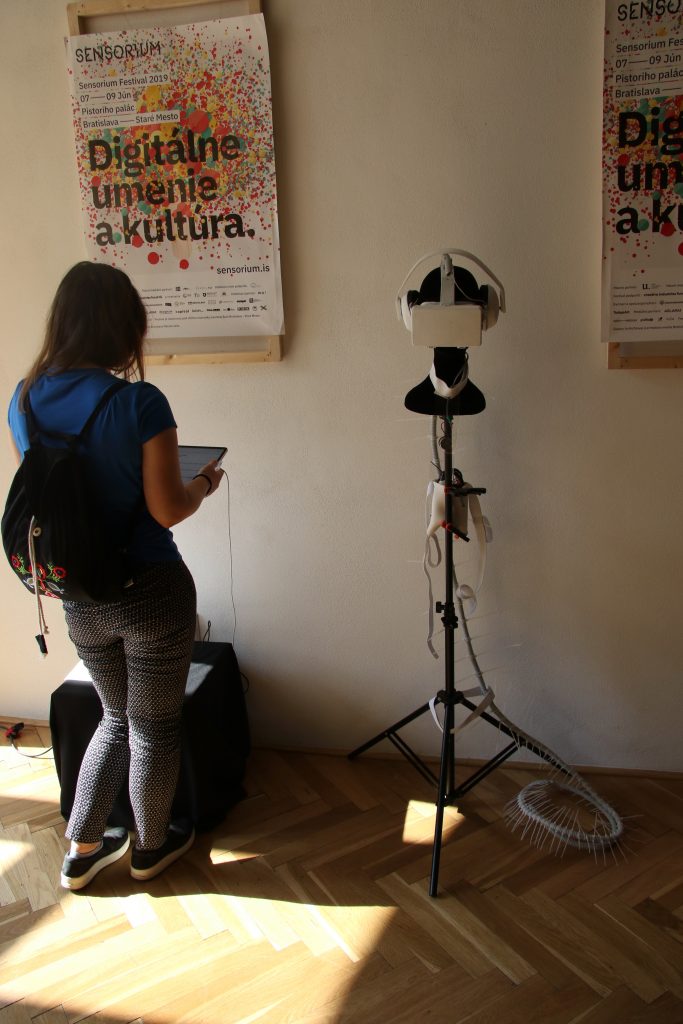
Description of the project: In the semiotic theories of Jakob von Uexküll and Thomas A. Sebeok, umwelt (plural: umwelten; from the German Umwelt meaning “environment” or “surroundings”) is the “biological foundations that lie at the very epicenter of the study of both communication and signification in the human [and non-human] animal”. Snake’s umwelt explores the basic senses of snakes which differ consistently from human sensory perception, the main dissimilarities being:
- SIGHT
Snakes use an infrared heat-sensing system. This heat seeing ability allows vipers to hunt their preys in complete darkness.
- HEARING / TOUCH
Snakes lack an outer ear. Instead, they are sensitive to sound-induced vibrations. They absorb vibrations through the ground and determine the size of the prey or danger by its movements.
- SMELL / TASTE
Snakes have both nostrils and nasal cavities, but they are not used to smell. Instead, the flicking tongue is actually a smelling device.
Diaries of stillness
by Bushra Burge
(Bushra had to leave before the show case, therefore her work was presented via this video)
Description of the project: What would be the bare minimum of anything for us to understand something? If we start to puncture this information saturation, how much void can we mine before sinkholes appear in our perception-reality?
06/06/19 Entry 1: stále
Attention fatigued Burge starts her enquiry earnestly with a morning walk into Mestské lesy v Bratislave to document and experiment non-stimulation…. the increasingly elusive spaces in-between. Her only part was to be as invisible and to observe and capture. Through this immersion she of course stumbles upon her own stillness.
This work in progress is an interactive multi-modal haptic-virtual reality wearable. The virtual visual aspects abstracts with particles (visualized from mental health data) with a 3D painted sculpture wrapped in the movie diary capture – representing her stillness. The subject’s pulse rate live-modulates the forest sounds and haptically actuates via bone conductance behind the ear. This is the first of a series of explorations of stillness diary entries.
Radio Neural Network
by Juan Duarte
(Juan also had to leave before the show case, therefore his work was presented via this video)
That concluded The Augmented Attention Lab Bratislava! We are so forever grateful for the organizers at Sensorium Festival, the wonderful mentors George and Marcello, and not least all the incredible and hard-working participants that made this experience so magical!

